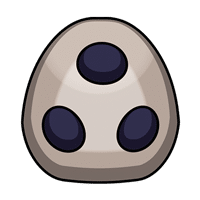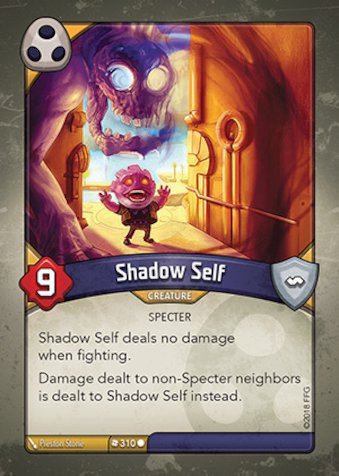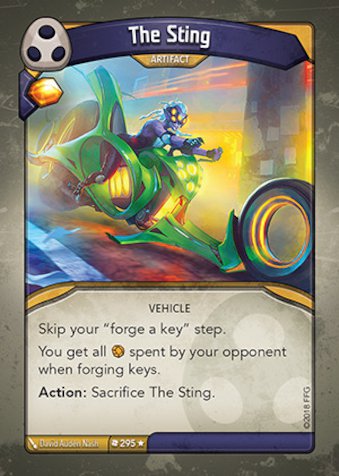OFrom the perplexing labs of House Logos, we venture to the dark veil of our penultimate house. Sneaky, clever, and too damn eager to run off with your wallet, let me introduce you to House Shadows!
 Keyforge: Overview of House Shadows
Keyforge: Overview of House Shadows
To use the words of Old Bruno (from his tale in “What Hides in the Shadows”), “[House] Shadows is and isn’t. Shadows isn’t a place, a people, a thing.” To unwrap this riddle, House Shadows is more of a mentality shared among the Svarr elves (and those like them) than it is any particular shared home, or lineage. And that mentality is (to quote Old Bruno again) “seeing what needs done an’ doing it. Is taking what you can take and slipping out none the wiser.” This philosophy embodies stealing or scavenging what you need using your speed, guile, and just a little bit of luck. In other words, House Shadows can exist anywhere, and be a part of anyone who chooses to follow this philosophy and lifestyle.
That being said, there is a degree more organization than this description initially suggests. House Shadows have largely consisted of the Svarr elves who have predominently adopted this philosophy. The Svarr elves are small, dark-skinned, large-eyed people who are characterized as having “wicked grins and sharp senses.” Though physically unimposing, the Svarr wield their cleverness and speed as weapons that can be as dangerous as the strength of a Brobnar giant. The Svarr have taken to establishing loose guilds of like-minded rogues, con artists, and occasional assassins. Though willing to rob and exploit any outsider, the members of House Shadows have an oddly selfless nature towards like-minded members, many willing to sacrifice much for the good of their guild. Since Shadows is carried in the heart of the person, the House can exist anywhere alongside the other tribes and Houses of the Crucible. Though dominated by the Svarr’s cultural influence, humans and other aliens have integrated themselves within the House.

As to where this House emerged, the history of the Svarr speaks of a land of light and peace where they originated from, but due to some event they were exiled to live in the Shadows where they were forced to eke out a living scavenging and stealing. An alternate history is told by Old Bruno suggesting an anti-heroic figure known as the First Thief who stole fire from the gods and shared it with the Svarr. Though it is uncertain, it is thought that the Svarr have migrated from their home world to the Crucible.
Specializing in stealth, misdirection, and theft, it is no surprise that the overwhelming majority of technology possessed by House Shadows has been stolen from other tribes and Houses, or otherwise scavenged or repurposed. They have been able to even reprogram the faeries that monitor the biospheres of the Crucible (most belonging to House Untamed) and have been able to use them as spies, scouts or couriers. One aspect of their technology is unique to themselves, and that is their insidious cloaks. Their cloaks, possessing stealth emitters, can produce a field of invisibility, shielding themselves from the gaze of others. Definitely useful for running away with æmber, which House Shadow has a notorious reputation for doing.
When they are not stealing or scavenging, member of House Shadows do have a fondness for gambling games, particular those that can be cheated. As Old Bruno says, “You see, Shadows isn’t just this game. It’s every game, every con an’ gaff an’ gimmick.”
Ever pragmatic, House Shadows regards the Archons as worthwhile allies who have the potential to bring great wealth to their guilds; though they are equally wary of any figure that wields as much power as the Archons do. The Archons, who for their part do not really grasp the concept of personal property, find House Shadows’ blend of selfless sacrifice and ruthless exploitation to be as fascinating as it is useful.
 Keyforge: Using Shadows in Your Deck
Keyforge: Using Shadows in Your Deck
As their namesake implies, House Shadows is focused on stealth and misdirection. This faction is all about exploiting opportunity for your advantage, forgoing raw strength for the ability to strike at your opponent’s resources. Shadows creatures are notoriously Elusive in combat, and are quick to either Steal aember or repurpose the opponent’s things in order to turn the tides in their favour.
Making great use of their stealth cloaks, the creatures of House Shadows are very hard to hit. Possessing the greatest number of creatures with the keyword Elusive, opponents of House Shadows will have to work very hard to track down the members of Shadows. Elusive means that the first time a creature with the trait is attacked, no damage is dealt by either side. So the attacker doesn’t hit the creature, but neither does the creature with Elusive retaliate. After the first attack, a creature with Elusive can be fought as normal. This works in favor of House Shadows, as most of their creatures do not hit very hard at all, but typically possess potent effects to gain or steal æmber for their side.
While hiding, the creatures of House Shadows, are eager to Steal some precious æmber. Just like with Elusive, House Shadows has the highest number of creatures and action cards that allow them to Steal. Stealing is, in my humble opinion, probably the best possible course of action one can take in Keyforge. You deprive the opponent of their much needed æmber while gaining some for yourself. This alone makes Shadows such a force to be reckoned with this game, where the game is more about resource acquisition than it is about fighting (sorry Brobnar).
When they’re not hiding or stealing, House Shadows is busy repurposing the opponent’s things. This works differently from outright Stealing (which is a specific mechanic) and relates to House Shadows’ ability to take control or use the opponent’s cards against them. This largely falls in the domain of cards like Nexus, who can use an opponent’s artifact against them; Sneklifter, who can just nab the artifact; and Smiling Ruth, who can outright take control of a creature. Nothing is more glorious than executing your opponent’s downfall with their own tools!
 Keyforge: Key Shadows Cards
Keyforge: Key Shadows Cards
So now let’s peer into the darkness, and take a look at some Shadows cards. First card I want to take a look at is The Sting.
The Sting is quite the ride (literally). You can’t forge keys, but you get whatever your opponent spends on forging their keys? That’s quite the trade off. This card does what I call “tether” the players together. No matter how well the opponent does, you will be a step behind nabbing up the æmber they spend. This can be both a powerful advantage, or a curse. This card needs to be used very strategically, otherwise it can lose you the game. The fact of the matter is, skipping your forge a key step for as long as you have The Sting can put you further behind than you think. When both players have two keys forged, and are approaching the finish line, The Sting can really hold you back. This card is best played towards the beginning of the game, especially against opponents who generate more æmber than you. Once you’ve been able to snag a key’s worth of æmber, it is best to ditch The Sting and ride it out from there. This card can be paired insidiously well with Untamed’s Key Charge or Chota Hazri, which get around missing your forge a key step.
One of the most beloved and feared cards in the game, a carefully played Bait and Swtich is always a gamechanger and a surefire way of turning the tables on your opponent. Continuously stealing from your opponent until you have as much as them is just downright evil. This is the achilles heel of decks that can generate massive amounts of æmber. Even against opponents with more modest pools of æmber, this can snag a key they can forge out from under them while putting you closer to the lead. The best advice for this card is to not use it too prematurely. Use it only when you know it will change the game, as its power to change the game cannot be understated. I’ve seen some squandered uses of Bait and Switch, which quickly led to losses that could’ve been victories if they were held on to just a little bit longer.

This guy is interesting. He is effectively the first and (currently) only damage sponge in the game. While Bulwark protects his neighbors by providing them with armor, and creatures with Taunt protect their neighbors by getting in the way of attackers, Shadow Self does it by soaking up the damage from them. This is an interesting tactic compared to the mechanic of Taunt, because Shadow Self will also take any damage from any source, whereas creature with Taunt only get in the way of attackers trying to fight. Though Shadow Self only protects non-specter creatures, Shadow Self is currently the only specter in the game, so its effect is wide-ranging. In this sense, I find Shadow Self to be the most effective defender in the game since it is so versatile. The downside is that it is often shortlived, even with its hefty nine power. And sadly, it does no damage on its own (which is fair given its beefy power). That being said, I’m never disappointed when I see Shadow Self in my deck. F
 House Shadows Final Thoughts
House Shadows Final Thoughts
If I had to pick a House that best fit the nature of Keyforge as a game, it would have to be Shadows. It is sneaky, strategic, and outright genius. And it is for that reason that I find myself somewhat at odds with the House. It feels some of the best mechanics and effects have been hoisted upon Shadows. I love that, for once, the sneaky thieves in the shadows get to have a time (ironically) in the spotlight in a game, but I feel like I would be happy if some of the other Houses get some of the devious tricks that Shadows has access to. Keyforge is still a very young game, so I am excited to see where the developers take it. It is clear that Shadows has had some serious love from its makers, and though that’s okay, I want everyone to have a bit of that love down the road.
Alas, my friends, we are reaching the finish line. I have saved the best for last, and next time we will be visiting my all time favourite House, the maniacal House Mars.


